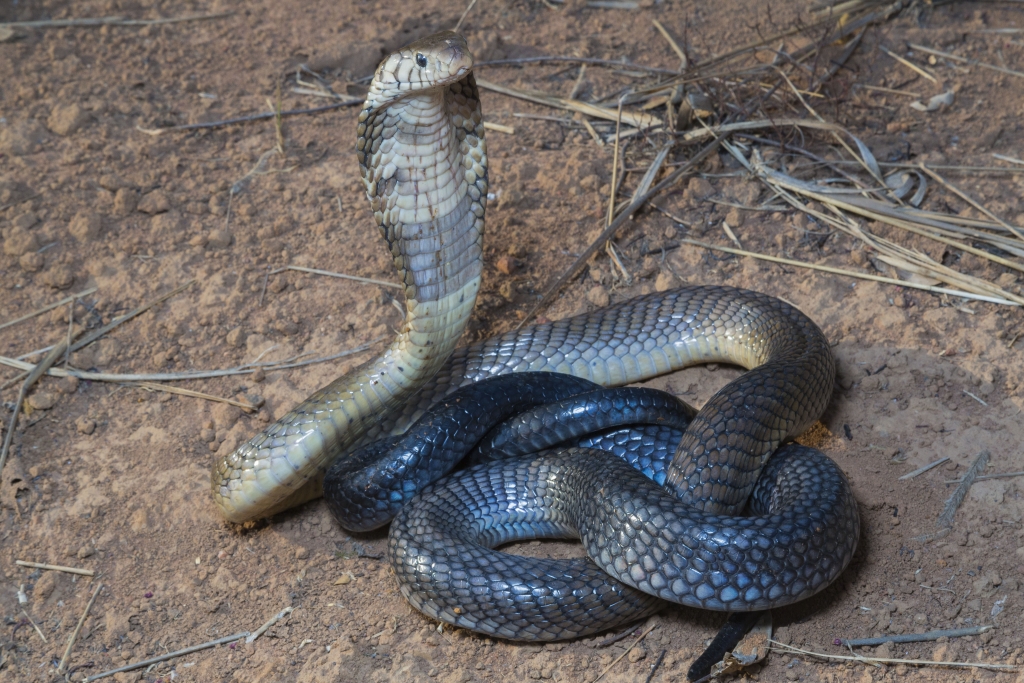Five Distinct Species of Forest Cobras
Forest cobras were previously thought to be a single species, but recent research has shown that they are actually five distinct species:
- Black Forest Cobra (Naja guineensis)
- Central African Forest Cobra (Naja melanoleuca)
- São Tomé Cobra (Naja peroescobari)
- West African Banded Cobra (Naja savannula)
- Brown Forest Cobra (Naja subfulva)
These five species are all highly venomous and can be dangerous to humans. However, they are also important members of the ecosystems in which they live, and they play a role in controlling populations of rodents and other small animals.
Below we give a short overview of each species distribution, color-pattern and size.
Black Forest Cobra (Naja guineensis)
Distribution: Guinea-Bissau, Guinea, Liberia, Sierra Leone, Ivory Coast, Ghana, Togo.
Size: Up to 2220 mm.
Color-pattern: Body above uniform brownish-black. Top of head dark brown anteriorly with a black posterior. Bottom and sides of head creamy white, with lips and supralabials edged in black. Underneath: tail and belly black becoming yellow with irregular black bands on the hood area and a yellow-white chin.
Habitat: Forest.
Central African Forest Cobra (Naja melanoleuca)
Distribution: Benin, Nigeria, Cameroon, CAR, Gabon, DRC, Republic of Congo, Angola
Size: Up to 2670 mm.
Color-pattern: Uniformly black above with a brown head. Belly black, with 4-6 black bands on a yellow neck. Lips and supralabials barred in yellow and black. Rarely a circular mark is seen on the back of the hood.
Habitat: Forest.
São Tomé Cobra (Naja peroescobari)
Distribution: Only found on the island of São Tomé in the Gulf of Guinea (centre and south of the island).
Size: Up to 2600 mm.
Color-pattern: Uniform black above with white throat bands. Chin and sides of head creamy, with lips edged in black.
Habitat: Forest.
West African Banded Cobra (Naja savannula)
Distribution: Senegal, Gambia, Guinea, Ivory Coast, Ghana, Togo, Benin, Mali, Burkina Faso, Nigeria, Niger, Chad, Cameroon.
Size: Up to 2230 mm.
Color-pattern: Top of head brown. Sides and bottom of head pale creamy yellow. Lip scales (labials) bordered in black. Neck brown above becoming black towards the rear. Neck strongly banded above with the bands fading around midbody. Underside a pale creamy hood area,with black bands, gradually becoming uniform black.
Habitat: Savanna and forest-savanna mosaic.

Brown Forest Cobra (Naja subfulva)
Distribution:
Chad, Nigeria, Cameroon, CAR, DRC, Republic of Congo, Rwanda, Burundi, Uganda, Kenya, Tanzania, Somalia, South Sudan, Ethiopia, Mozambique, Malawi, Zambia, Zimbabwe, South Africa, Angola.
Size: Up to 2690 mm.
Color-pattern: Head brown, becoming black posteriorly. All black specimens known from Congo basin and near Lake Victoria. Neck-banding vague, or absent.
Habitat: Forest, thicket, woodland and forest-savanna
mosaic.
Conservation status
All five species of forest cobra are currently listed as Least Concern by the IUCN Red List of Threatened Species. However, some of these species could be more vulnerable to habitat loss and bushmeat hunting than others. For example, Peroescobari’s forest cobra has a very restricted range, and it could be threatened by deforestation in its habitat.
Conclusion
Forest cobras are fascinating and important creatures. They play a vital role in the ecosystems in which they live, and they are a reminder of the diversity of life on Earth. It is important to protect these snakes and their habitats so that they can continue to thrive.




